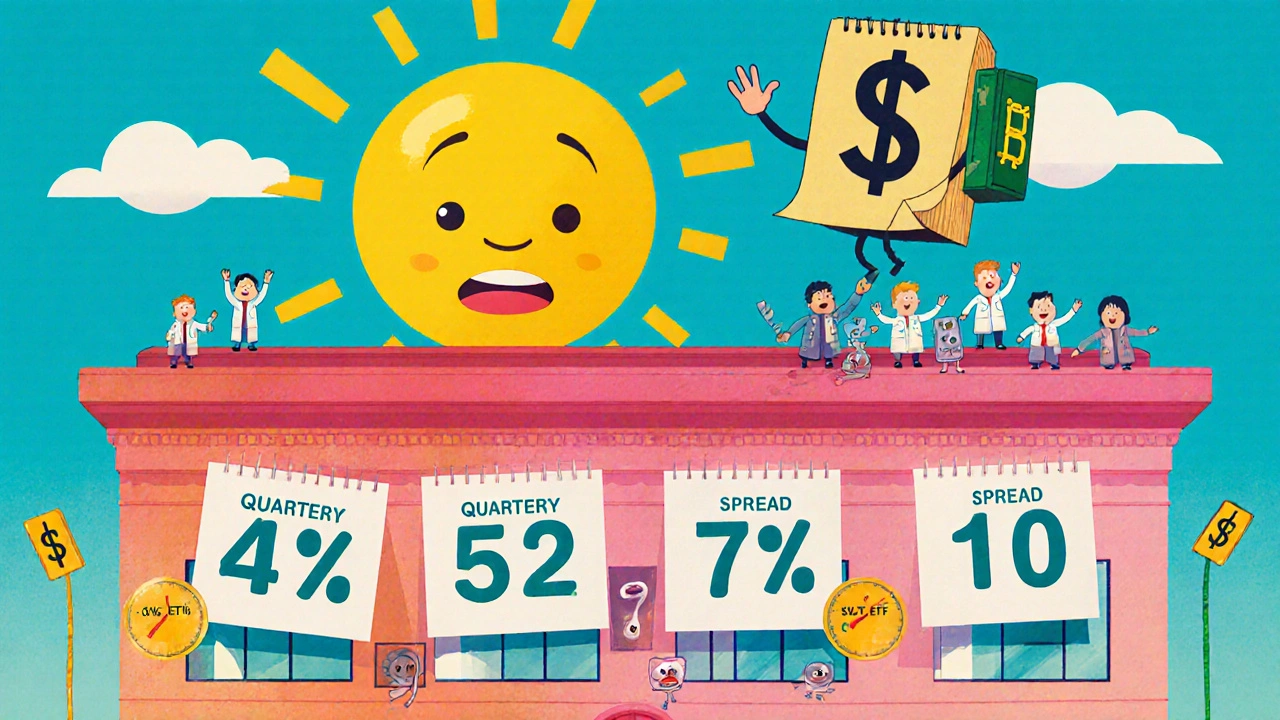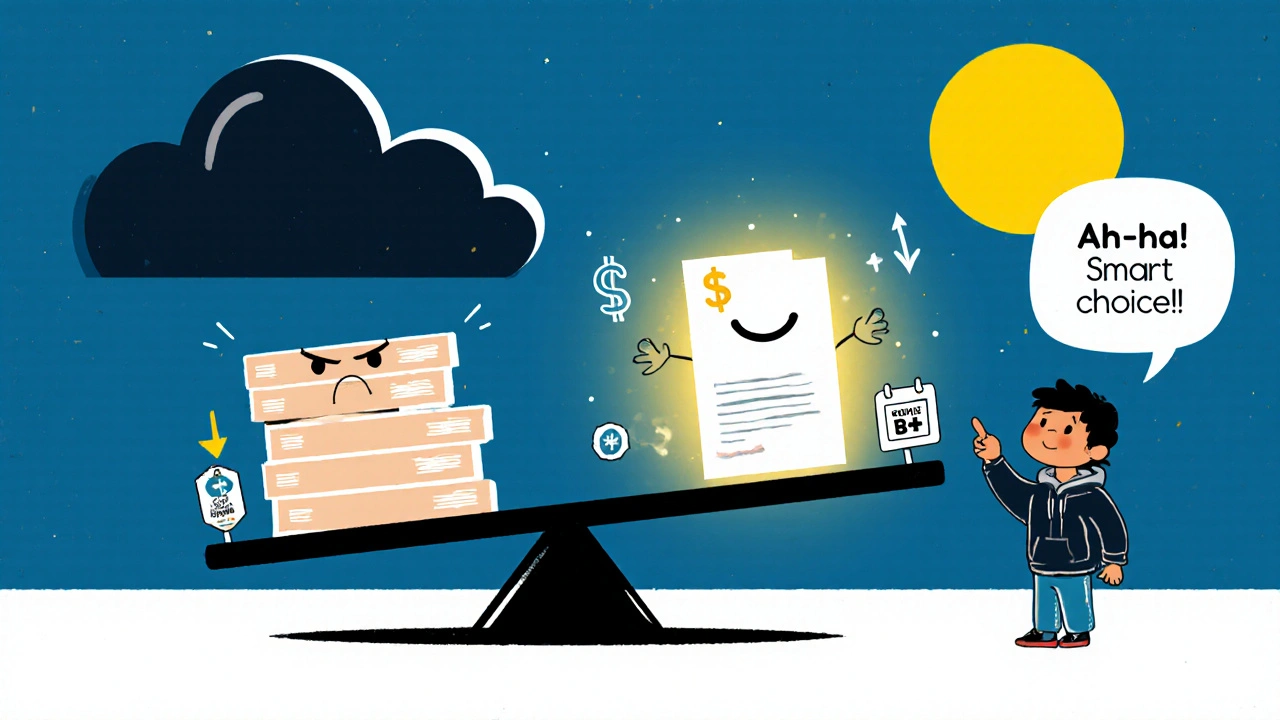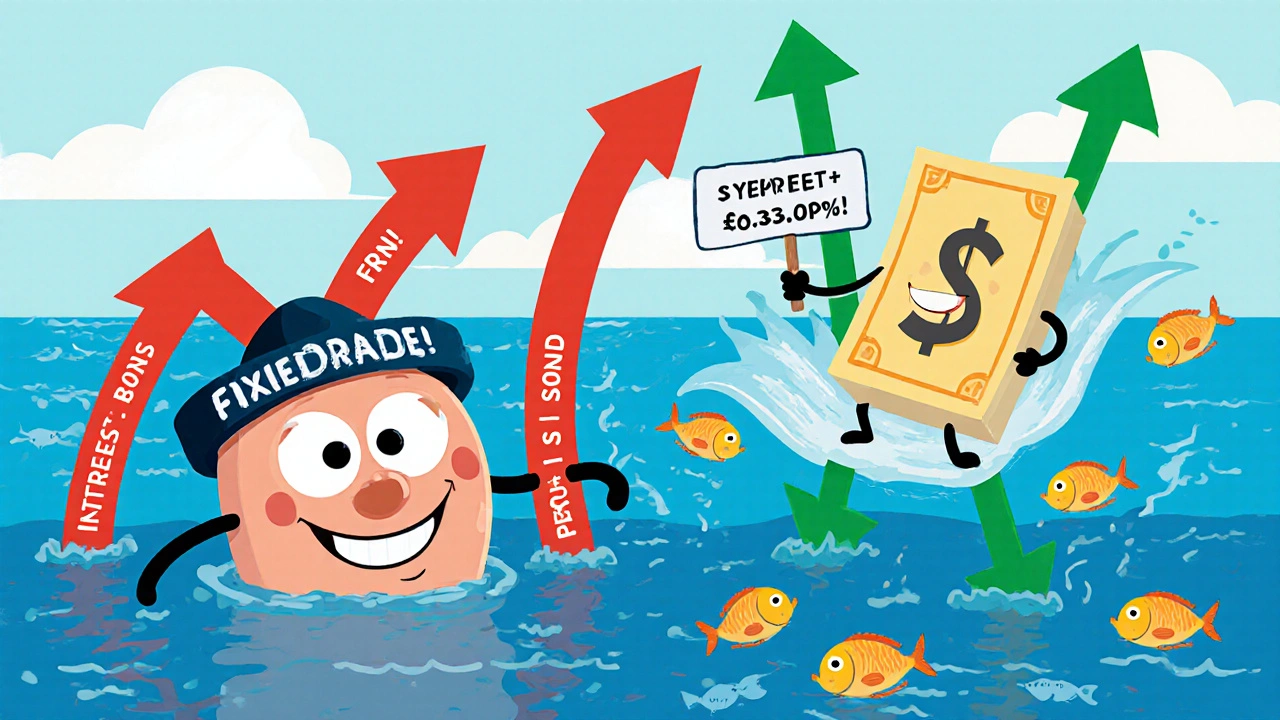Floating Rate Note Calculator
Calculate Your Floating-Rate Note Payments
Enter current benchmark rate, spread, and reset frequency to see how your FRN payments change with market rate shifts.
Current Payment Results
How Rates Change
When interest rates rise, your FRN payments increase automatically. See how this compares to fixed-rate bonds:
Unlike fixed-rate bonds, FRNs adjust with market rates. If rates fall, your income falls too—but you won't lose principal due to rate increases.
When interest rates climb, most bonds lose value. If you own a 10-year bond paying 3%, and new bonds start offering 5%, your bond becomes less attractive. Its price drops to make up the difference. But there’s a type of bond that doesn’t behave this way-floating-rate notes. These aren’t magic, but they’re one of the few fixed-income tools designed to move with the market instead of against it.
How Floating-Rate Notes Work
Unlike traditional bonds with fixed coupons, floating-rate notes (FRNs) pay interest that changes every few months. The rate isn’t random-it’s based on a benchmark, like SOFR (Secured Overnight Financing Rate) or the 3-month Bank Bill Swap Rate (BBSW), plus a fixed spread. For example, an FRN might pay SOFR + 0.30%. If SOFR is 4.5%, you get 4.8%. When SOFR jumps to 5.1%, your payment rises to 5.4%.
This reset usually happens quarterly. That means if rates go up, your income goes up too-no waiting for maturity. The spread-the extra 0.30% in our example-is set when you buy the note and stays locked in. It reflects the issuer’s credit risk. A company with strong finances might offer a smaller spread. A riskier issuer pays more to attract buyers.
Why They Outperform Fixed-Rate Bonds in Rising Rate Environments
Fixed-rate bonds and rising rates are a bad combo. As rates climb, bond prices fall. The longer the bond’s maturity, the steeper the drop. A 10-year bond might lose 8-10% of its value if rates rise 1%. But FRNs? Their prices stay much more stable.
Why? Because the market doesn’t need to discount their future cash flows. Each payment is already priced for current conditions. If SOFR rises, the next coupon reflects that. Investors don’t panic and sell. That’s why FRNs show far less price volatility than fixed-rate bonds during rate hikes.
During the Federal Reserve’s 2022-2023 tightening cycle-where rates jumped from near zero to 5.5%-FRNs delivered consistent returns. While many fixed-income funds lost ground, FRN-focused ETFs like iShares Floating Rate Bond ETF (FLOT) gained value as their coupons adjusted higher. By September 2023, FLOT’s assets had grown from $6.2 billion to $10.7 billion, showing how institutional and retail investors alike turned to them for protection.
Who Issues Floating-Rate Notes?
FRNs aren’t just for big banks or corporations. Governments, supranational agencies like the World Bank, and even large non-financial companies issue them. The most common issuers are financial institutions-banks and insurance companies-because they naturally hedge their own rate exposure.
In October 2023, Commonwealth Bank of Australia issued a $500 million FRN paying 2.05% over the 3-month BBSW rate. That’s a real-world example of how even major global banks rely on FRNs to raise capital while managing their own interest rate risk.
Corporate FRNs are typically investment-grade. That means they’re considered low-risk from a credit standpoint-but not zero risk. If an issuer’s financial health worsens, investors will demand a higher spread. Even if SOFR stays flat, your FRN’s price could fall because the market now wants SOFR + 0.50% instead of SOFR + 0.25%.

Types of Floating-Rate Notes
Not all FRNs are created equal. There are variations designed for specific market conditions:
- Standard FRNs: Reference rate + fixed spread. The most common type.
- Floored FRNs: Have a minimum coupon rate. If SOFR drops below 1%, you still get paid 1%. Useful in uncertain rate environments.
- Capped FRNs: Maximum payment. If SOFR hits 6%, your coupon stops rising at 6% + spread. Limits upside but reduces volatility.
- Collared FRNs: Both floor and cap. Gives you some protection on both ends.
- Leveraged FRNs: Pay 1.5x or 2x the reference rate. Higher returns, but much more sensitive to rate swings. Risky.
- Deleveraged FRNs: Pay only half the reference rate. Lower income, but less volatility.
Most retail investors stick with standard FRNs or FRN ETFs. Leveraged and deleveraged versions are mostly used by hedge funds and professional traders.
What You Lose with Floating-Rate Notes
FRNs aren’t perfect. They shine when rates rise-but they underperform when rates are stable or falling.
If the Fed pauses or cuts rates, your coupon drops. You might earn less than you did on a fixed-rate bond you bought two years ago. That’s the trade-off: protection in rising markets, but lower income in flat or falling ones.
Another hidden risk: credit risk. FRNs protect you from interest rate moves-but not from the issuer going bankrupt. If a company’s earnings collapse or its debt load balloons, the market will punish the note’s price, even if SOFR stays the same.
Also, cash flow is unpredictable. If you rely on bond income to pay bills, FRNs make budgeting harder. You can’t lock in next year’s payments like you can with a fixed-rate bond.
How to Invest in Floating-Rate Notes
You don’t need to buy individual FRNs to get exposure. Most retail investors use ETFs:
- iShares Floating Rate Bond ETF (FLOT): Holds U.S. dollar-denominated FRNs from banks and corporations. Low expense ratio, high liquidity.
- Invesco Floating Rate ETF (FLOT): Similar to FLOT, with slight differences in holdings.
- SPDR Bloomberg Floating Rate ETF (FLOT): Tracks a broad index of investment-grade FRNs.
If you want to buy individual FRNs, you’ll need a brokerage that offers bond trading. Look for issues with:
- Short-term maturities (2-5 years)
- High credit ratings (BBB- or better)
- SOFR or BBSW as the reference rate (avoid LIBOR-linked notes-they’re outdated)
- Quarterly resets
Always check the prospectus. It tells you the spread, reset schedule, and issuer details. Don’t just assume the coupon will keep rising-it depends on the benchmark, not the Fed’s intentions.

FRNs vs. Other Rate-Hedging Tools
There are other ways to hedge rising rates:
- Inflation-linked bonds (TIPS): Protect against inflation, not interest rates. Their coupons adjust for CPI, not SOFR.
- Interest rate swaps: You can swap fixed payments for floating ones-but these are complex, require large capital, and are mostly for institutions.
- Short-duration bonds: Less sensitive to rate hikes, but don’t adjust their coupons. Still lose value when rates rise.
FRNs are the simplest, most direct way to get floating-rate income from a bond. They’re cheaper and easier than swaps. More transparent than structured notes. And better than short-term bonds because they actively adjust.
Market Outlook and Future Trends
As of late 2025, interest rates remain elevated. The Federal Reserve has signaled it may hold rates steady for a while-but doesn’t rule out further hikes if inflation flares up. That keeps FRNs relevant.
FRN issuance hit $287 billion in 2022, up 32% from 2021. That trend continues. The World Bank, European Investment Bank, and major U.S. banks are all still issuing new FRNs. SOFR has fully replaced LIBOR, making pricing more reliable.
Experts predict FRN adoption will grow, especially as more retail investors use ETFs. Institutional investors are already increasing allocations. A 2023 PIMCO survey showed 67% of 150 institutional portfolios had increased FRN exposure over the prior year.
But don’t expect FRNs to replace fixed-rate bonds. They’re a tool, not a replacement. Use them to balance your portfolio-not to chase the highest yield.
Bottom Line: When to Use Floating-Rate Notes
FRNs are a smart choice if:
- You’re worried about more rate hikes
- You want to reduce bond price volatility
- You’re comfortable with variable income
- You’re investing through ETFs or high-quality issuers
Avoid them if:
- You need predictable monthly income
- You expect rates to fall soon
- You’re not comfortable with credit risk
FRNs don’t eliminate risk-they shift it. You trade price risk for income uncertainty. But in today’s environment, that’s often the better deal.
Are floating-rate notes safe?
Floating-rate notes are relatively safe from interest rate risk, but they still carry credit risk. If the issuer-like a bank or corporation-gets into financial trouble, the note’s price can fall even if interest rates stay flat. Stick to investment-grade issuers and consider ETFs for diversification.
Do floating-rate notes pay monthly?
No, most FRNs pay interest quarterly. Some may pay monthly, but those are rare and usually structured products for institutions. Standard FRNs reset every three months, and payments follow shortly after.
What’s the difference between SOFR and LIBOR?
LIBOR was a benchmark rate based on bank estimates, which was manipulated in the past. SOFR is based on actual overnight lending transactions between banks and is much more transparent. All new FRNs issued after 2021 use SOFR. Avoid any FRNs still tied to LIBOR-they’re outdated and being phased out.
Can I lose money on floating-rate notes?
Yes. While FRNs protect you from falling bond prices due to rising rates, you can still lose money if the issuer’s credit rating drops, the market demands a higher spread, or you sell before maturity at a discount. They’re not guaranteed principal like savings accounts.
Are floating-rate notes good for retirees?
They can be, but with caution. Retirees needing stable income may find the variable payments unsettling. If you’re using FRNs as part of a diversified portfolio-say, 20% of your bond allocation-they can help reduce overall volatility. But don’t rely on them as your sole income source.




FRNs are the only fixed-income tool that actually makes sense right now. I sold my entire 10-year treasury stack last year and rotated into FLOT - no regrets. When SOFR jumped from 4.2% to 5.3% in eight months, my quarterly income went from $1,120 to $1,410. Meanwhile, my old bond fund lost 7% in value. The market doesn’t lie - if you’re holding fixed coupons in a rising rate environment, you’re just gambling with your principal. FRNs don’t promise miracles, but they do promise alignment with reality.
It is fascinating, really, how the evolution of financial instruments mirrors the broader human struggle to reconcile certainty with uncertainty. Floating-rate notes, in their elegant simplicity, offer a quiet rebellion against the illusion of control - we once believed we could lock in returns for decades, as if time itself were a static ledger. But the world, as it turns out, is not a spreadsheet. The reset dates, the SOFR, the spreads - they are not mere numbers, but signals of a market that refuses to be tamed. And yet, we still cling to the comfort of fixed payments, as if income were a moral right rather than an economic contingent. Perhaps the true risk is not in variable yields, but in our refusal to adapt.
Bro, SOFR is the new LIBOR but less sketchy - no more bank guesswork, just actual repo transactions. That’s why all new FRNs are SOFR + spread. And yeah, FLOT is the go-to for retail. But don’t sleep on the corporate FRNs - some of the BB+ ones from energy firms are paying SOFR + 0.85% right now. You’re getting yield premium without the junk bond volatility. Just check the issuer’s debt covenants. And no, they don’t pay monthly. Quarterly. Get over it. Also, avoid those capped FRNs unless you’re in a Fed panic. You’re leaving money on the table.
Let’s be real - if you’re still asking whether FRNs are ‘safe’ for retirees, you probably still think bonds are ‘safe’ because your grandpa told you so. FRNs aren’t for people who need predictable income - they’re for people who understand that the Fed doesn’t care about your budget. You want stability? Buy gold and cry. FRNs are the only thing in fixed income that doesn’t pretend the economy is frozen in 2019. The fact that institutional portfolios increased allocation by 67% in a year? That’s not a trend - that’s a revolt. If you’re not in them, you’re not investing - you’re just waiting for the next crash to blame on ‘market volatility.’